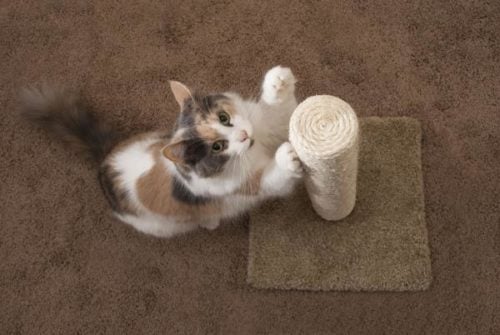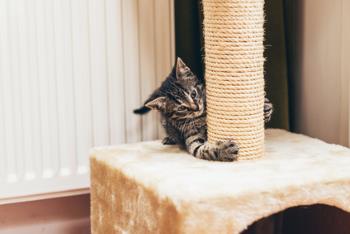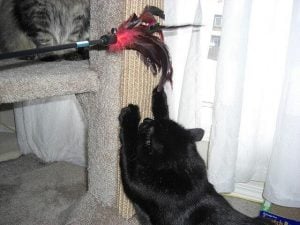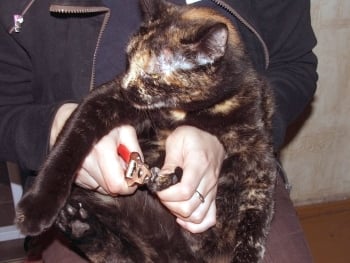Is your cat scratching furniture? Does he use his claws on anything and everything but a scratching post? We know the frustration when couch, carpet, wallpaper, basically everything gets destroyed in only a few minutes. When you get a new piece of expensive furniture, it’s most likely that your cat will try and scratch it. Is there a way to stop it? So glad you asked! Of course there is.

In this article, you are going to learn how to stop your cat from scratching furniture, walls, and carpets, without punishing, declawing, or getting rid of your cat.
IMPORTANT: Scratching is NOT an expression of dislike toward you or your furniture. Cats scratch because they require it naturally; similar like they need to eat or sleep. If you want your cat to stop “breaking in” your furniture, you don’t have to train him not to. You have to redirect his scratching to objects that are more appropriate. For example, that beautiful scratching post you just got him.
Why do cats need to scratch
The most common reason why cats destroy furniture at homes is there aren’t enough or improper placement of scratching posts. In many cases people don’t like to see a scratching post in a plain view. Do you want a scratching post to be focus of your home? Right. The bad news — cats on the opposite need them in a plain view. Why?
To answer the above question, let’s first take a look at why cats scratch:
- Claw maintenance. Most people know that their cats sharpen their claws while scratching. This is true, but if it were the only reason, you could indeed tuck the post away. Then you could get it out, once a week for nail maintenance. But there are more important things involved in scratching.
- Exercise. Cats also stretch while they scratch. This must be done daily, and from our experience, if your cat’s “gym” is too far away, he or she will just choose a closer match. Like your couch.
- Territory marking. Scratching leaves visual marks and a scent from the cat’s paw pads. In your cat’s opinion, these marks cannot be left at just any place. Every location where they are distributed is important to your them. This means that cats need to scratch in specific locations. And not just one of them.
You will find more detailed explanation here: Learn why cats need to scratch.
Where to place cat scratching posts
You’ve probably noticed that scratching is a location-dependent activity. A convenient location for scratching for exercise is important. But even more crucial is the need to mark territory; marking needs to be at exact locations.
For example, if you leave a post-it note, you don’t put it in a random obscure location. You leave it in plain view, where you will see it and it’ll do its job to remind you to order more scratching posts. Like you, your cat needs to leave their scratch marks in plain view. Ideally (to them, not you), along common paths in the house. And this is where you should place scratching posts:
- Places them where your cat scratches already. By scratching at those locations, your cat is telling you where he wants the posts to be. You don’t need to understand cat language or figure out why your cat scratches in a certain location. She’s already telling you. If your cat scratches in a certain place, they want to scratch right there. Easy.
 Near your cat’s activity spots. We recommend at least one post or pad in every room where your cat spends a lot of time. More posts are preferred. Especially where you and your family gather together. If your cat naps frequently on a couch, she is very likely to scratch it. That’s a perfect place for you to place a post nearby. If your cat watches birds through a window, it’s very likely he will need a scratching post or pad nearby.
Near your cat’s activity spots. We recommend at least one post or pad in every room where your cat spends a lot of time. More posts are preferred. Especially where you and your family gather together. If your cat naps frequently on a couch, she is very likely to scratch it. That’s a perfect place for you to place a post nearby. If your cat watches birds through a window, it’s very likely he will need a scratching post or pad nearby.- Near pathways. Wild cats leave scratch marks along their usual everyday paths. They especially do that in places where they cross the paths of other cats. Even if you don’t have other cats, marking is instinctive and marks can be left. In your house, places like door frames, furniture, and corners that are between a napping location and where you feed them are commonly marked. Place a scratching post or a few along the way. Wall pads are great for this purpose, since you can put them on a wall in hallways or on corners.
- Next to the home entrance. For house cats, the only entrances in their territory are usually the front door, back door, and maybe some windows. It is a good idea to place a scratching post (or even a cat tree with a perch) near the entrances. This way, your cat will be able to leave scratch marks for visitors to see and climb on an elevated napping location to securely observe whoever comes in.
These four points should give you a clear picture about where your cat wants scratching posts and pads. If you aren’t sure, it’s always a good rule to introduce as many as you can and place them evenly throughout the whole house. Then watch to see which ones are used, and if any are not. Move the unpopular ones and watch.
What cat scratching posts you should choose
Scratching posts don’t need to be huge and take up most of your living space. Of course, you could have a large cat tree in the busiest area of your house. It’s also okay to have many smaller posts and pads spread throughout your house.
Not all scratching posts are created equal. Learn more about scratching posts here. Depending on your cat’s preferences, the best cat scratching posts are covered with sisal rope, regular rope, or bare wood.
Regarding form and type, you have three options:
- Post on a base. These can be a small single post with a toy tied to its top. Or they could be a large post that has rope-covered pillars. It’s sensible to have a few larger ones in some central places of your house and smaller ones throughout the house.
- Pad attached to the wall. This provides a vertical scratching area, but unlike a post, it doesn’t take up space on your floor. Usually, these can be strategically placed throughout the house. These are best placed along the pathways taken by your cat. Put them at different heights and use different shapes and sizes.
- Scratching pads placed on the ground. Your cat may prefer horizontal scratching, and most cats like it to some degree. Horizontal posts provide a different scratching experience. They work great if your cat claws the carpet. If that’s the case, you can simply place the pad near or even on top of the scratched location.
NOTE: The most important things to look for in a scratching post or pad are their size and stability. Bigger posts should provide your cat with the room to do a whole body stretch. Stability is important, because cats are unlikely to scratch wobbly surfaces. They are inconvenient and useless for stretching purposes. The same goes for jumping on cat trees; if they are too wobbly, your cat will not feel secure on them.
How to train a cat to use a scratching post
Getting good and appropriate scratching posts and placing them in the right locations is one thing. Getting your cat to use them is not guaranteed.
Here’s how to encourage a cat to use a scratching post:

- Perfect location. Nothing is as effective as the right scratching post in the right place. Which object to scratch is not as important for your cat as where to scratch. If you guess where this “where” is, you are likely to get away without any training. See above for details.
- Use an interactive toy. Start by playing with your cat and letting him catch the toy while it sits on a scratchable surface. He will not only get his claws into the toy, but into the post, too. Because of the cat’s instinctive behavior, he will pick up the rest.
- Scratch the post with your own fingers. The noise created will make your cat curious about the post.
- Catnip the post. Not all cats respond to catnip, but those who do are likely to rub, chew, and scratch objects that smell of catnip. If your cat gets her claws into the cat tree because of catnip, she is likely to understand the benefits of the scratchable surface. You can buy catnip packs in pet stores and on-line; just get a small pinch and rub it onto the scratching post surface. Seal the rest of the catnip in an airtight container.
DO NOT put your cat’s paws on the post’s surface using force. This will not work. It will likely make your cat confused and stressed. Worse, she will be likely to avoid the negative experience in future by not coming close to the post…or to you.
Prevent your cat from scratching your furniture
The fact that you got your cat to favor the scratching post does not guarantee that he will not use old spots such as your sofa, carpet, or walls. The easiest workaround is to make those places physically inaccessible or undesirable for scratching.
- Use double-sided sticky tape. You can put some tape over the scratched surface, and your cat will lose interest in it, because instead of sharpening claws, the surface will now stick to her paws.
- Block access with a scratching post. Place a post in front of or on top of the scratched surface. It’s very likely that your cat will choose the post instead of your sofa.
- Cover the location with a plastic sheet. These are generally used as table covers and can be obtained in many sizes and shapes. Just place one on top or in front of the scratched area, or attach it to the wall with tape. The hard and slippery surface is completely inappropriate for scratching and will be less interesting to your cat.
- Rearrange furniture. Put undesired spots out of comfortable reach for your cat. For example, if your cat prefers a certain area of a wall, you can place a chair in front of it. Just temporarily.
- Apply a repellent spray. There are sprays that deter cats. You can spray it upon the scratched surface, and your cat will avoid coming close to it. However, the spray must be reapplied frequently.
NOTE: If you deter your cat from using one location for scratching, they will look for another spot nearby. This is good because this new location could be the scratching post you placed there for them.
Trim your cat’s claws to lower the damage done by scratching
The above tips are guaranteed to stop your cat from scratching the furniture, though nothing can guarantee that your cat will never, ever use her claws on things other than a scratching post. But you can lower the damage done by trimming your cat’s claws, which must be done approximately every 2 to 4 weeks.
One thing that prevents cat owners from taking this step is fear. How can you trim your cat’s claws without getting scratched? It is not as bad as it sounds. It is best to start slowly. Get your cat used to being in your lap while you touch their paws. Gradually build towards trimming them. Make this as pleasant experience for them as possible from the start.
You can find more information about cat claw trimming here.

If you push your finger in between your cat’s paw pads, his claws will protrude out. You will see that your cat’s claw is partially transparent, and there is a blood vessel inside it. Use cat claw clippers to trim the claw taking great care to avoid trimming the vessel.
IMPORTANT: Declawing, as convenient as it first sounds, is not at all a good choice. It is cruel, ethically controversial, and illegal in many countries. It often promotes other behavior problems. Declawing is not only a removal of claws, but actually an amputation of the fingertips, which causes pain while healing and when walking afterwards. Declawing is a very common cause for cats not using their litterboxes, along with many other behavior problems.
If you really want your cat’s claws to stay out of trouble, try to use vinyl caps instead. They can be glued on top of your cat’s claws; as the claws grow, the caps must be reapplied about once a month. Claw caps can be easily applied at home. You can ask your veterinarian to teach you how to “install” them easily. They come in a huge variety of colors, so you can protect your furniture with style. There are also transparent ones if you do not want a cat to have better looking nails than you.
So, are you ready to stop your cat from scratching your furniture? We bet you are. Add more scratching posts, block access to the undesired spots, and start trimming your cat’s claws on a regular basis. This means that even if your cat follows his natural behavior (scratching sofas, that is), there will be no damage done.
If you struggle with other behavior problems of your cat check our list of solution to most common ones here.
